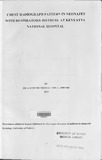Chest radiograph pattern in neonates with respiratory distress at Kenyatta National hospital

View/
Date
2011Author
Gachuiri, Thomas T
Type
ThesisLanguage
enMetadata
Show full item recordAbstract
Mostof the global neonatal deaths occur in developing nations, are from pulmonary related
causesfor which a plain chest radiograph is the radiological investigation of choice in the initial
diagnosisand subsequent follow up (4,6,8)
There being no local published studies available, my study will act as a baseline upon which
future studies can improve on to inform policy. Such information is critical in planning evidence
basedinterventions.
Objectives
Themain objective of this study was to describe the chest radiographic pattern in neonates with
signs and symptoms of respiratory distress admitted to the new born unit of Kenyatta National
Hospital.
Methods
A cross-sectional descriptive study was carried out over a period of 4 months between September
and December 2010. All patients who met the selection criteria during the study period were
included in the study after obtaining an informed consent from their guardians/parents.
The study was performed using a portable Philips PRACTIX 160 X-ray machine manufactured
in October 2006.
Each chest radiograph was reviewed by the researcher and a consultant radiologist. The findings
were recorded in the data collection form of each participant. The data was analyzed using a
computer programme; SPSS 15 and the results presented in form of tables, graphs and charts.
Results
A total of 100 neonates were recruited during the study period. 23% of the study population
were prematures. The study participants comprised 51 males (51%) and 49 females (49%)
representing a Male-Female ratio of 1.04: 1.
The mean age of neonates studied was 5.3 days with a range from 1 to 30 days.
8
The mean weight of the 100 neonates at birth was 2.1 kilograms (SD=0.9) and the range 0.8 to
4.6 kilograms. An Apgar score was available for most neonates at birth (87%) and at 5 minutes
(68%). However only 22% of the neonates has a score recorded 10 minutes after birth.
The neonates presented with respiratory symptoms with tachpnoea highest at 54%, chest wall
indrawing at 45% and grunting and nasal flaring in that order.
The most common causes of respiratory distress among neonates were respiratory distress
syndrome (41.1%), transient tachpnoea of the newborn (16.8%) and Pneumonia (15.8% )
.Neonatal septicemia was the primary cause of respiratory distress in 4.2% neonates.
Non-pulmonary causes of respiratory distress were diagnosed in six neonates presenting with
cardiac problems and metabolic disorders. Among the five children with cardiac problems
congenital heart disease was the most common diagnosis (n = 3).Upper airway obstruction as a
result of choanal atresia also seen as one case of respiratory distress.
Most of the chest radiographs had ground glass opacification 32%, reticulonodular 10% and
nodular opacity at 3%. The type of opacification showed a statistically significant association
with the neonate's diagnosis.
48% of premature neonates had abnormal chest radiographic which was not statistically
significant p=0.34
68% of the neonates had some form of indwelling tube, catheter or line. Nasal gastric tube was
found in majority followed by endotracheal tubes and chest ECG leads.
The endotracheal tubes were the most affected in misplacement at 20% followed by nasogastric
tubes at 13.7%
Conclusion
Respiratory Distress in neonates is a clinical entity that requires proper ante and intrapartum
history, however for accurate separation of entities chest radiography plays a very pivotal role.
Chest radiographs in this study were able to differentiate between the surgical and the medical
causes as well as characterize the medical causes. This correlated well with previous studies. (9)
Citation
Master of medicine in diagnostic RadiologyPublisher
University Of Nairobi College of Health Sciences
